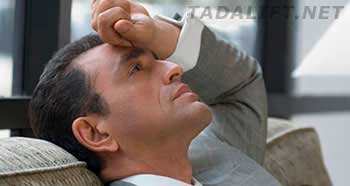What is known as menopause in women is called andropause in men. The condition is associated with age-related changes in the levels of male hormone. Testosterone deficiency, late-onset hypogonadism, androgen deficiency and similar conditions have the same symptoms as andropause.
The key peculiarity of the disorder is a significant drop in the production of testosterone, which is typical for men over 50 years old. Produced in the testes, testosterone is an inevitable fuel for sexual strength and drive, successful puberty, physical and mental health, as well as proper muscle functioning and several other health processes. Comparing male and female menopause, it is possible to single out several important differences. First of all, andropause is experienced not by all men, and then it is not related to complete shutdown of the male reproductive system. On the other hand, sex-related disorders can appear as a result of decreased testosterone concentration.

Male Menopause Symptoms and Possible Solutions
Similar to female menopause, male andropause can be associated with problems of the psychological, physical and sexual character. The condition aggravates as a man ages. Following the statistics, the most typical and commonly experienced symptoms can include:
- Low motivation;
- Decreased energy;
- Anxiety;
- Depression;
- Decreased self-confidence;
- Serious sleeping abnormalities;
- Gynecomastia;
- Erectile dysfunction;
- Infertility;
- Low bone density;
- Low muscle mass;
- Reduced libido and others.
Breast tenderness and swelling, baldness, hot flashes and other symptoms can also hit a patient. Fortunately, similar to other health disorders, the symptoms of male menopause can be improved and managed. Serious lifestyle changes should be introduced, including decreased stress, balanced sleep, regular exercising and following a healthy diet. More dangerous instances will require medical interference and some serious treatments, such as hormone replacement therapy. Antidepressants and other remedies can be prescribed to patients who cannot deal with depression and anxiety launched by andropause.

